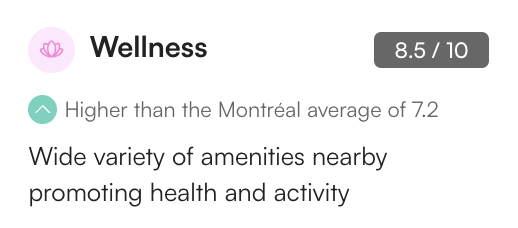Our 2025 Year in Review
Product
| 17 Dec 2025

To say health and wellness have become a focus of our lives and decision-making over the past two years would be a severe understatement. A focus on wellness has become not just a “nice to have” amenity offered by forward-thinking companies but a necessity to keep employees and residents healthy as well as attract and retain talent and tenants.
Landlords and investors are embracing Well Building and Fitwel certifications with gusto. As these standards continue to evolve, a recent Deloitte white paper points out that “real estate professionals are uniquely positioned to lead and advance the adoption of well-being indicators.” However, these healthy building certifications are limited in their focus on the asset itself, while in truth, wellness can and should be supported beyond the four walls regardless of asset type. Indeed, the surrounding area significantly impacts its occupants’ health and wellness.
Regardless of asset type, people who use, build, live in, or invest in these spaces demand more. As a result, the stakes are now higher than ever, which is why meaningful, objective measures of location characteristics have become table stakes.
Responding to headwinds of regulatory change and consumer demand, institutional investors require ESG reporting. However, the industry is only starting to find its way to somewhat standard metrics – which often miss the mark for more significant impacts by only focusing on embodied carbon or energy and water efficiencies within the asset itself.
Here location can also represent costly climate risk, GHG emissions from transportation to daily needs, and the availability of sustainable power. It can mean measuring improvements to livability and equitable access to rapid transit, schools, grocery stores, employment centers, and parks – just to name a few.
On the other side of the spectrum, home buyers and renters are looking for more space as their home functions not only as a residence but also as a school, gym, yoga studio, office, and gathering spot. In addition, they are commuting less frequently and looking for closer access to the amenities and services that cover their daily needs.
Like the office, these people are looking to augment what their spaces provide by choosing a neighborhood and location that match their lifestyle and values, including environmental sustainability concerns. They are looking – ultimately – for quality of life.
Multifamily developers and single-family rental investors are paying attention to those location preferences and the increasing demand in secondary and tertiary cities that they may not have been active in before.
Quality of life is even more critical when some workers theoretically can work from wherever they choose to live. Population migration has accelerated with our increased workplace flexibility, and people are voting with their feet in more ways than one. They are moving to markets that allow more affordability and livability.
In fact, Area Development lists Quality of Life as the fourth most important site selection criteria in 2021 – following talent availability, access to highways (we’ve got a score for that too), and access to low-cost energy.

At Local Logic, we believe that wellness is an integral part of considering a location’s quality of life and a major driver of a location’s value, so much so that we are excited to announce the addition of our new location score to quantify it.
Like so many aspects of location, “wellness” is a term that can seem broad and difficult to measure and understand objectively, therefore making it challenging to consider in financial models and due diligence.
To build our new Wellness Score, we leveraged a proprietary model measuring the proximity of wellness amenities, such as healthy restaurants, food, gyms, and farmers’ markets, as well as an in-depth analysis of over 250M addresses included in Local Logic’s Pedestrian-Friendly and Park Scores.
Because it is so essential to the people eventually using these spaces, wellness is also a critical lens to understanding how the amenities of a surrounding area can augment programming and leasing plans in new mixed-use assets, marketing, and leasing efforts.
The real estate industry now understands that it is crucial to consider how a location supports wellness in corporate site selection, home searches, and asset acquisitions. This is because wellness directly impacts the value of an asset and a development’s positive impact on its surrounding community.
Investors are starting to understand this as they push environmental, social, and governance or ESG imperatives on their portfolios. While health and wellness have been chronically overlooked in ESG, the pandemic’s impacts have made it impossible to ignore these concerns any longer. Investors are now including health and wellness in their considerations. Doing good has an enormous effect on what is good for business.

Local Logic’s Wellness Score as shown in Local Content
The Wellness Score highlights the asset’s strengths by showcasing the activities in the surrounding area and how these contribute to the well-being and experience of the users.
Additionally, when used in conjunction with our other Location Scores, the Wellness Score supercharges your understanding of the desirability of the asset’s location when deciding where to invest or build and comparing it with other sites.
The Wellness Score is part of Local Logic’s Location Score API and can be provided separately from other scores. Additionally, many of the points of interest associated with the Wellness Score will be available in our updated Points of Interest API.